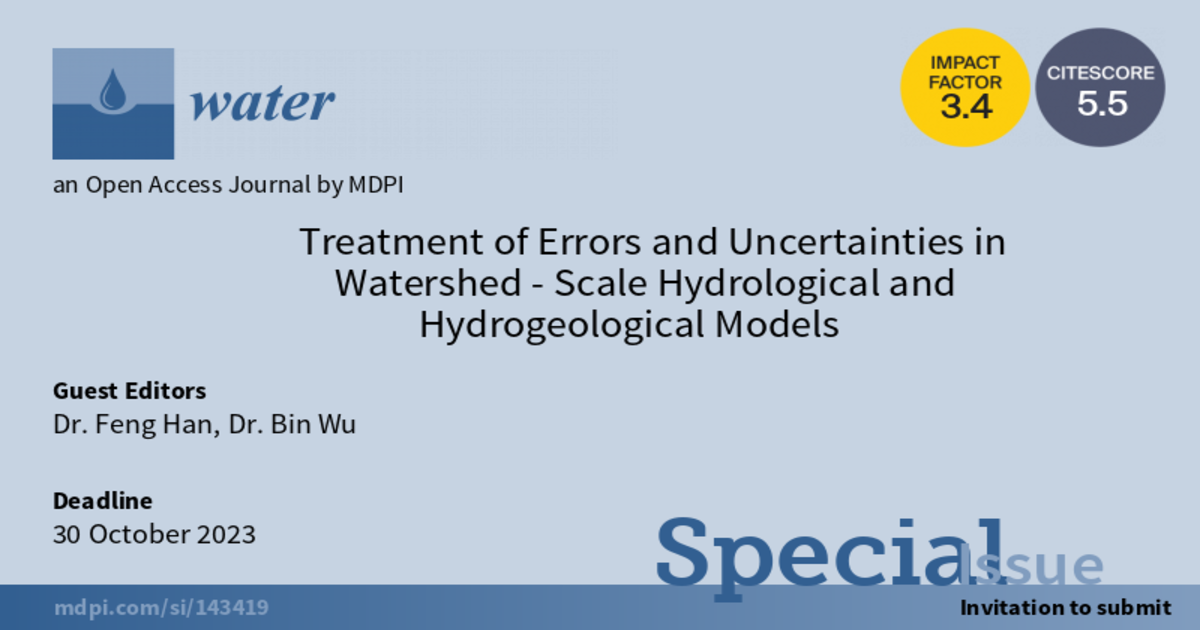Treatment of Errors and Uncertainties in Watershed-Scale Hydrological and Hydrogeological Models
A special issue of Water (ISSN 2073-4441). This special issue belongs to the section "Hydrology".
Deadline for manuscript submissions: closed (30 October 2023) | Viewed by 3037

Special Issue Editors
Interests: hydrological modeling; ecological modeling; water quality modeling; uncertainty analysis; data assimilation; Bayesian inference; Markov chain Monte Carlo; machine learning; HEIFLOW
Special Issue Information
Dear Colleagues,
Hydrological models have developed significantly over the past few decades, from simple lumped empirical models to complex physically based integrated surface water–groundwater models. Recently, some studies have even combined hydrological process equations with machine learning (ML) models to form hybrid physics–ML hydrological models. Despite significant developments in model structure, the common errors and significant uncertainties in the modeling results have perplexed model users, and even affect the correctness of our knowledge and understanding of the real-world water cycle system. In terms of uncertainty quantification, early studies have tried a variety of methods, such as parameter sensitivity analysis, stochastic response surface methods, variance decomposition, and Rosenblueth's method. Now, the Bayesian inference-based method is the most popular method to treat modeling errors and quantify uncertainties. Initially, Bayesian inference methods treated all sources of uncertainty (i.e., parametric, input, structural and observational) in a lumped manner. Later, more complex Bayesian frameworks, such as hierarchical Bayesian models, were developed to comprehensively describe, infer and evaluate uncertainties from multiple sources. More recently, the rapid development of ML models has brought opportunities for the interpretation of errors and the quantification of uncertainty in hydrological models. Some influential work has emerged. Despite improvements in methodology, one major challenge facing the hydrological modeling community is to address the high computational costs of these methods, which may require thousands to millions of model runs, especially for computationally expensive models. More efficient methods/algorithms/tools are still highly sought after.
This Special Issue focuses on the treatment of errors and uncertainties in watershed-scale hydrological modeling, considering research on the development and application of new methods, specifically. Application research on the error interpretation and uncertainty quantification of complex hydrological models (such as hydrogeological models), as well as studies on related water systems (such as water quality) are also welcome.
Dr. Feng Han
Dr. Bin Wu
Guest Editors
Manuscript Submission Information
Manuscripts should be submitted online at www.mdpi.com by registering and logging in to this website. Once you are registered, click here to go to the submission form. Manuscripts can be submitted until the deadline. All submissions that pass pre-check are peer-reviewed. Accepted papers will be published continuously in the journal (as soon as accepted) and will be listed together on the special issue website. Research articles, review articles as well as short communications are invited. For planned papers, a title and short abstract (about 250 words) can be sent to the Editorial Office for assessment.
Submitted manuscripts should not have been published previously, nor be under consideration for publication elsewhere (except conference proceedings papers). All manuscripts are thoroughly refereed through a single-blind peer-review process. A guide for authors and other relevant information for submission of manuscripts is available on the Instructions for Authors page. Water is an international peer-reviewed open access semimonthly journal published by MDPI.
Please visit the Instructions for Authors page before submitting a manuscript. The Article Processing Charge (APC) for publication in this open access journal is 2600 CHF (Swiss Francs). Submitted papers should be well formatted and use good English. Authors may use MDPI's English editing service prior to publication or during author revisions.
Keywords
- hydrological model
- hydrogeological model
- uncertainty
- errors
- Bayesian inference
- machine learning
- data assimilation
- Monte Carlo simulation
- Markov chain Monte Carlo
- surrogate modeling
Benefits of Publishing in a Special Issue
- Ease of navigation: Grouping papers by topic helps scholars navigate broad scope journals more efficiently.
- Greater discoverability: Special Issues support the reach and impact of scientific research. Articles in Special Issues are more discoverable and cited more frequently.
- Expansion of research network: Special Issues facilitate connections among authors, fostering scientific collaborations.
- External promotion: Articles in Special Issues are often promoted through the journal's social media, increasing their visibility.
- Reprint: MDPI Books provides the opportunity to republish successful Special Issues in book format, both online and in print.
Further information on MDPI's Special Issue policies can be found here.






